Oops! Forgot to save that pasta water again, huh? We’ve all been there.
Pasta water is like gold in the kitchen – it thickens sauces and glues pasta and sauce together.
What do you do if you’ve already sent it down the drain?
No sweat. We’re about to dig into five kickass substitutes that’ll save your dinner.
Think of these as your kitchen’s pinch hitters, ready to step up to the plate.
Chicken broth? Absolutely. Milk? Why not.
Each substitute comes with its own set of perks, making your sauce stick to your pasta like they’re best friends.
Stay tuned as we turn kitchen oops into gourmet wows.
What is Pasta Water?

It seems like a contradiction in terms, but pasta water is a real thing – and it’s pretty useful.
When you cook pasta, the water absorbs some of the starch from the noodles.
This means that when you drain the pasta, there’s still a lot of flavor-packed starchy water left behind.
And that’s where pasta water comes in.
Pasta water can be used in recipes, from soups and stews to risottos and sauces.
It adds a boost of flavor and helps to thicken and enrich dishes.
Plus, it’s a great way to add some extra nutrition to your meal – all those vitamins and minerals from the pasta will end up in the water, so you’ll be getting a little extra boost every time you use it.
So next time you’re cooking pasta, don’t throw out that starchy water – put it to good use in your kitchen.
The 5 Best Substitutes for Pasta Water
Pasta water, the starchy liquid left after boiling pasta, is often used in various recipes to enhance the texture and flavor of sauces and dishes.
However, if you don’t have access to pasta water or need a substitute, there are several alternatives to consider.
In this guide, we will compare the top 5 substitutes for pasta water, discussing their key characteristics and suggesting proper ratios to help you find suitable alternatives.
| Substitute | Key Characteristics | Proper Ratio |
|---|---|---|
| Cornflour | Fine powder made from corn kernels with a neutral flavor and excellent thickening properties | Use 1 tablespoon of cornflour mixed with 2-3 tablespoons of water for every 1 cup of pasta water |
| Potato Starch | Starch derived from potatoes that adds a smooth and creamy texture to sauces | Use 1 tablespoon of potato starch mixed with 2-3 tablespoons of water for every 1 cup of pasta water |
| Tapioca Starch | Starch extracted from the cassava root, providing a glossy finish and great thickening power | Use 1 tablespoon of tapioca starch mixed with 2-3 tablespoons of water for every 1 cup of pasta water |
| Cornstarch | Fine powder made from corn kernels, similar to cornflour but with a higher starch content | Use 1 tablespoon of cornstarch mixed with 2-3 tablespoons of water for every 1 cup of pasta water |
| Xanthan Gum | Natural thickening agent that creates a gel-like texture and improves sauce consistency | Use 1/4 to 1/2 teaspoon of xanthan gum mixed with 2-3 tablespoons of water for every 1 cup of pasta water |
Now, let’s dive into each substitute in more detail:
1 – Cornflour
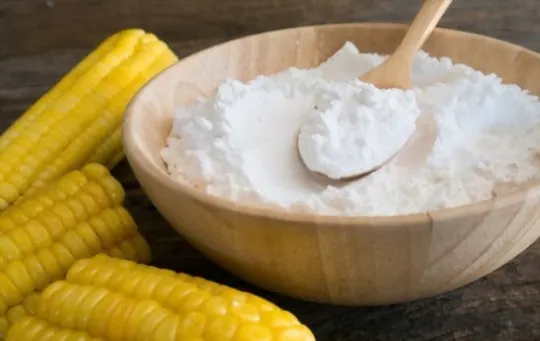
First on our list is cornflour, also known as maize flour.
Cornflour is made by grinding dried corn kernels into a fine powder.
The powder is then sifted to remove any coarse pieces.
The resulting flour is then bleached to achieve the desired color.
Cornflour can be either white or yellow, depending on the type of corn used to make it.
Cornflour is often used as a thickening agent for sauces and soups, and it can also be used to make breading and batters.
It can also be used as a replacement for wheat flour in recipes.
Cornflour is gluten-free and has a higher protein content than wheat flour.
It is also lower in calories and fat.
Cornflour is a great choice if you’re looking for a thick, rich texture and flavor.
- Key Characteristics: Cornflour is a fine powder made from corn kernels with a neutral flavor. It has excellent thickening properties, making it an ideal substitute for pasta water.
- Proper Ratio: Use 1 tablespoon of cornflour mixed with 2-3 tablespoons of water for every 1 cup of pasta water. Adjust the quantity based on the desired thickness of the sauce or dish.
2 – Potato Starch
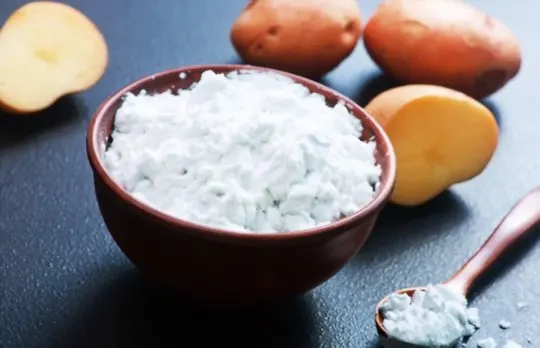
Potato starch is a fine, white powder produced by extracting the starch from potatoes.
It is commonly used as a thickening agent in soups and sauces, and it can also be used to make gluten-free flour.
Potato starch is high in carbohydrates and contains a moderate amount of protein.
It is also a good source of fiber. Potato starch can be used in baking or coating fried foods.
It is also sometimes used as a binding agent in pillows and mattresses.
Potato starch is relatively low in calories and has a neutral taste, making it a versatile ingredient for many different dishes.
- Key Characteristics: Potato starch is derived from potatoes and adds a smooth and creamy texture to sauces. It can be used as a substitute for pasta water, enhancing the consistency of dishes.
- Proper Ratio: Use 1 tablespoon of potato starch mixed with 2-3 tablespoons of water for every 1 cup of pasta water. Adjust the quantity based on the desired thickness of the sauce or dish.
3 – Tapioca Starch
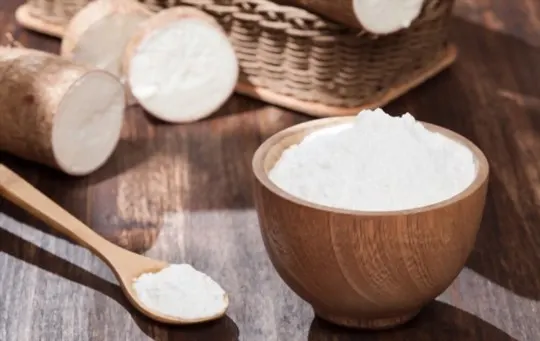
Tapioca starch is a versatile ingredient used in many different applications.
With its thick, glue-like texture and neutral flavor, tapioca starch can be added to baked goods, from cakes and biscuits to bread and granola bars.
It can also be used as a thickener for sauces and soups or a binding agent in meatballs or patties.
Additionally, because tapioca starch contains many essential nutrients like folate, potassium, calcium, and fiber, it can even be eaten on its own as a healthy and filling snack.
Whether you’re looking for the perfect ingredient for your latest baking project or want an easy way to add more nutrients to your diet, tapioca starch is worth checking out.
- Key Characteristics: Tapioca starch is extracted from the cassava root and provides a glossy finish and great thickening power. It can be used as a substitute for pasta water in various recipes.
- Proper Ratio: Use 1 tablespoon of tapioca starch mixed with 2-3 tablespoons of water for every 1 cup of pasta water. Adjust the quantity based on the desired thickness of the sauce or dish.
4 – Cornstarch
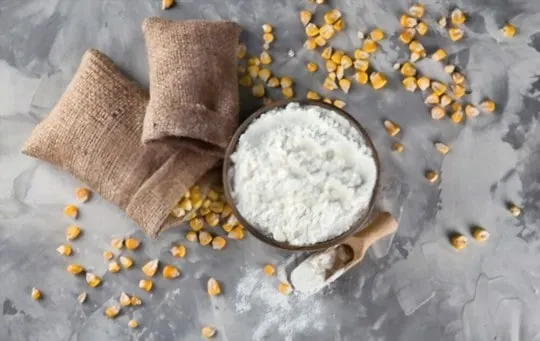
Cornstarch is a powder made from the endosperm of the corn kernel.
It is a versatile ingredient used in many different recipes, from thickening sauces to making gluten-free baked goods.
Cornstarch is also a great natural alternative to synthetic ingredients like xanthan gum.
When combined with water, cornstarch forms a gel-like substance that can be used as a binding agent or emulsifier.
It is also an effective thickener for soups, stews, and gravies.
In addition to its culinary uses, cornstarch can also be used as natural laundry starch or cleaning agent.
When combined with vinegar, cornstarch makes an excellent window cleaner.
It can also be used to polish silver and remove stains from clothing.
Whether you’re using it in the kitchen or the laundry room, cornstarch is a versatile ingredient that everyone should have on hand.
- Key Characteristics: Cornstarch is similar to cornflour but has a higher starch content. It can be used as a substitute for pasta water, offering excellent thickening properties to sauces.
- Proper Ratio: Use 1 tablespoon of cornstarch mixed with 2-3 tablespoons of water for every 1 cup of pasta water. Adjust the quantity based on the desired thickness of the sauce or dish.
5 – Xanthan Gum
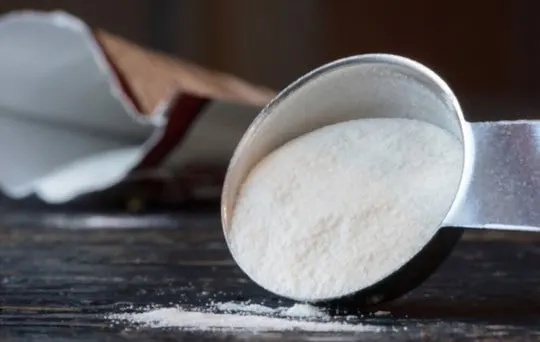
Xanthan gum is a food additive used to thicken and stabilize foods.
It is derived from a type of bacteria, and it is often used in gluten-free products as a replacement for wheat flour.
Xanthan gum has many benefits, including improving the texture of foods, preventing ice crystals from forming, and extending the shelf life of products.
It is also relatively safe to consume, although some people may experience digestive issues when eating large amounts of xanthan gum.
Overall, xanthan gum is a useful food additive that can help to improve the texture and quality of many different types of foods.
- Key Characteristics: Xanthan gum is a natural thickening agent that creates a gel-like texture. It improves sauce consistency and can be used as a substitute for pasta water.
- Proper Ratio: Use 1/4 to 1/2 teaspoon of xanthan gum mixed with 2-3 tablespoons of water for every 1 cup of pasta water. Adjust the quantity based on the desired thickness of the sauce or dish.
Conclusion
Pasta water is a necessary ingredient in many recipes, but it can be replaced with other liquids.
Some good substitutes for pasta water include corn flour, potato starch, and more.
Each of these substitutes has its unique properties, so be sure to choose the one that will work best for your recipe.
With a little experimentation, you should be able to find a suitable replacement for pasta water that works well in your dish.
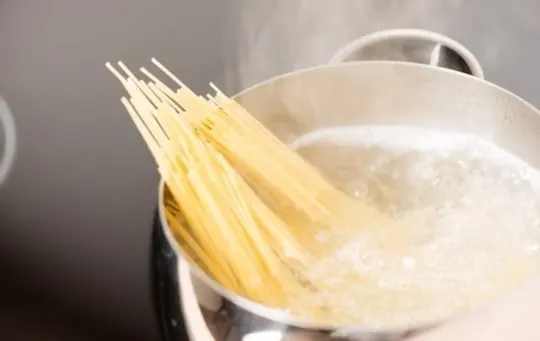
The 5 Best Substitutes for Pasta Water
Ingredients
- Cornflour
- Potato Starch
- Tapioca Starch
- Cornstarch
- Xanthan Gum
Instructions
- Pick your favorite substitute from the list above.
- Follow cooking directions for your selected substitute with the proper ratio of ingredients.

Andrew Gray is a seasoned food writer and blogger with a wealth of experience in the restaurant and catering industries. With a passion for all things delicious, Andrew has honed his culinary expertise through his work as a personal chef and caterer.
His love for food led him to venture into food writing, where he has contributed to various online publications, sharing his knowledge and insights on the culinary world. As the proud owner of AmericasRestaurant.com, Andrew covers a wide range of topics, including recipes, restaurant reviews, product recommendations, and culinary tips.
Through his website, he aims to inspire and educate fellow food enthusiasts, offering a comprehensive resource for all things food-related.

Leave a comment